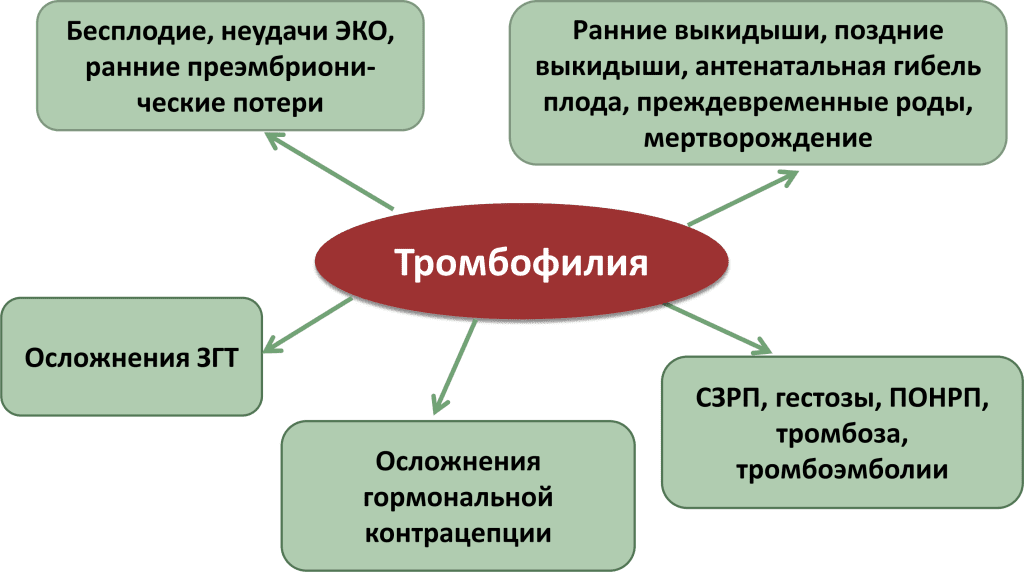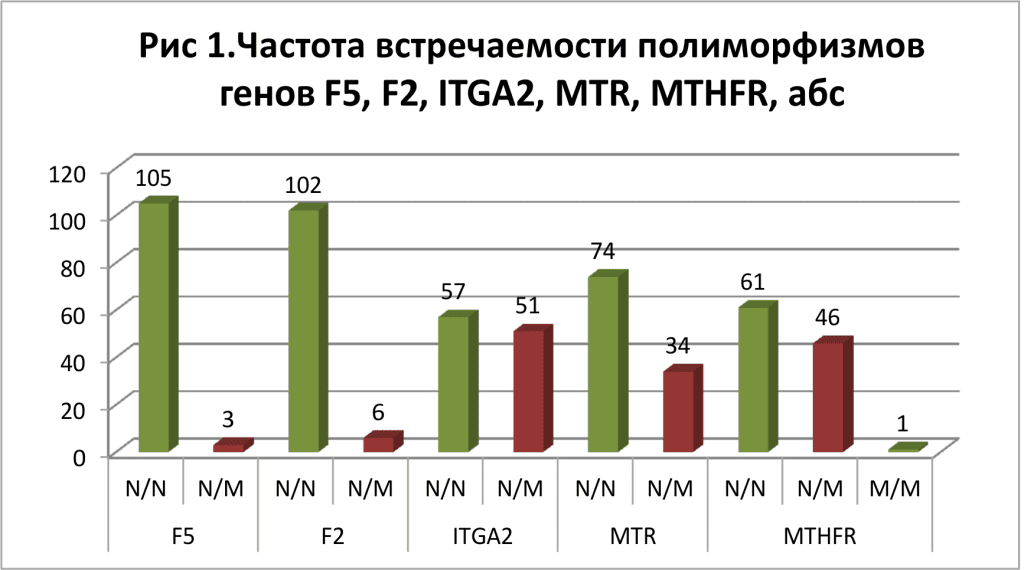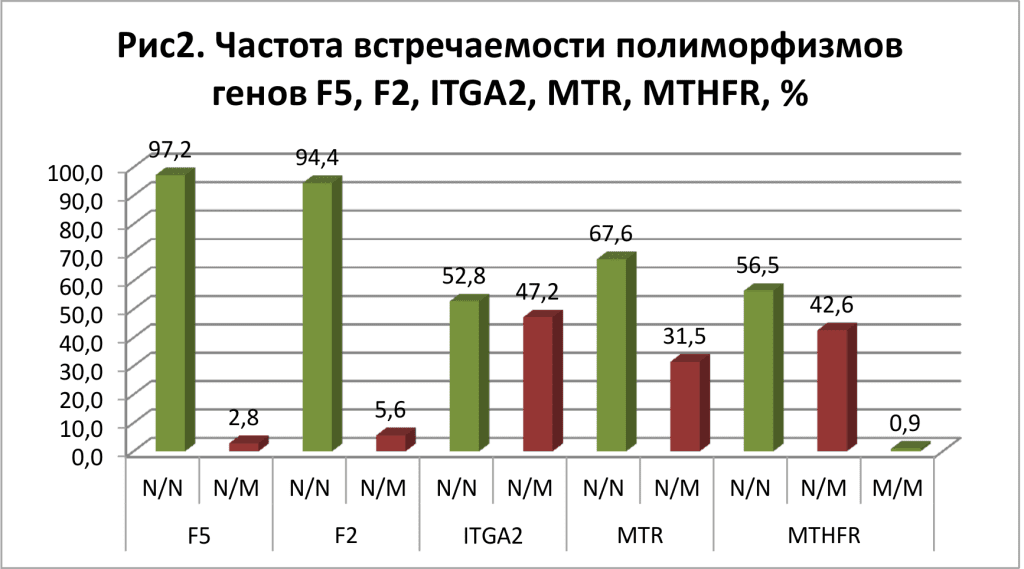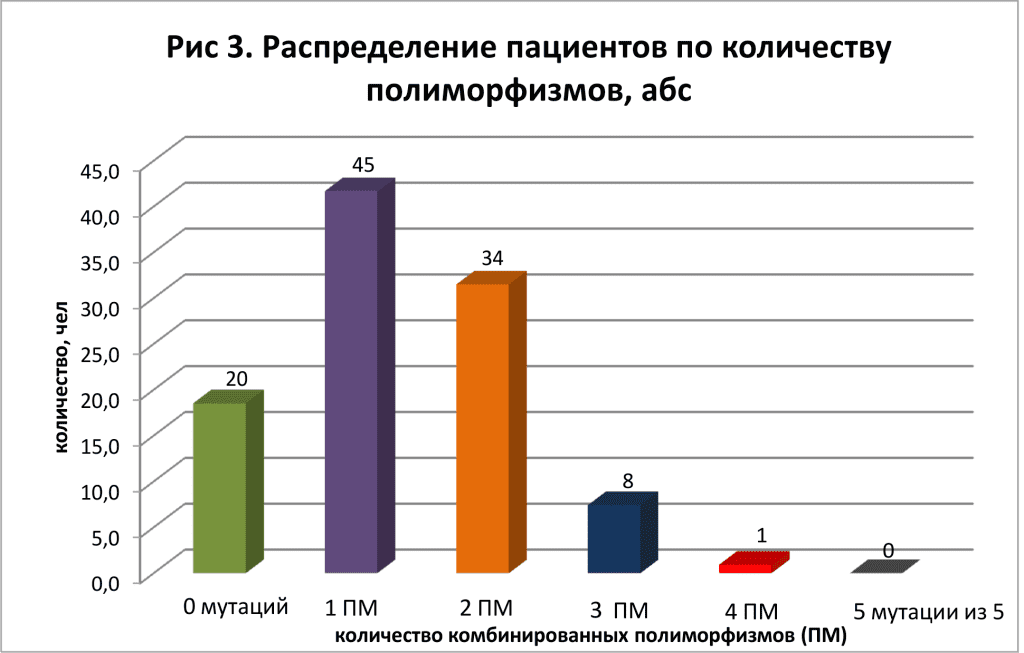FREQUENCY FREQUENCY OF HEREDITARY THROMBOPHILIA GENE POLYMORPHISMS IN PATIENTS WHO HAVE APPLIED TO THE TREEGENE GENETIC LABORATORY.
FREQUENCY OF INHERITED THROMBOPHILIA GENE POLYMORPHISM BASED ON TREEGENE GENETIC LABORATORY RESEARCH RESULTS
Numerous studies of hereditary thrombophilia in obstetrics and gynecology show the relevance of this pathogenetic mechanism in the development of pregnancy complications. This article analyzes the frequency of occurrence of polymorphisms of the F2, F5, ITGA2, MTR, MTHFR Based on the results of patients who contacted the lab TreeGene, Almaty. The study method was allele-specific PCR. 108 DNA samples were examined. The most frequent were mutations in platelet receptor genes and in the folate cycle system, and these were mostly heterozygous replacements. Only in one case a homozygous mutation in the MTFHR gene was detected. The most significant in the development of thrombophilia is the Leiden mutation (F-5) and prothrombin mutation (F-2) occur much less frequently.
Key words: Hereditary thrombophilia, mutation, Leiden mutation, F2, F5, ITGA2, MTR, MTHFR
Numerous studies exploring problems of genetic thrombophilia in obstetric show the pathogenetic mechanism of the development of pregnancy complications. This article analyzes the frequency of polymorphisms of F2, F5, ITGA2, MTR, MTHFR based on the results of TreeGene laboratory patients. Method of research is allele-specific PCR. It was analyzed 108 DNA samplest. The most frequent mutations in the genes of the receptors in the platelets and the folate cycle, mostly heterozygous substitution. Only in one case revealed a homozygous mutation in the gene MTFHR. Leiden mutation (F-5) and prothrombin mutation (F-2) are the most significant in the thrombophilia development and occur much less frequently.
Keywords: hereditary thrombophilia, mutation, Leiden mutation, F2, F5, ITGA2, MTR, MTHFR
Over the past decade, scientists and clinicians have paid close attention to the problem of hereditary thrombophilia as a component of the chain of pathological processes leading to a complicated pregnancy. According to a number of authors, the role of thrombophilia in the structure of pregnancy pathology causes ranges from 40% to 80%. From the modern point of view, thrombophilia is considered as an etiopathogenetic factor in a wide range of diseases and syndromes: fetal loss syndrome, preeclampsia, thromboembolic complications of hormonal contraception and hormonal replacement therapy, repeated failures of in vitro fertilization (IVF), etc. (Scheme 1).

The introduction of new high-tech molecular diagnostic methods into modern genetics has significantly expanded the concept of diseases related to the reproductive system. The most significant mutations whose presence increases the risk of thrombosis and pregnancy complications have been identified.
108 patients were examined in the TreeGene laboratory during the period from May 2013 to September 2014 in order to study polymorphisms of genes associated with thrombophilia. All patients were with complications of reproductive health or aggravated family thrombotic anamnesis, predominantly Astana and Almaty. The studied profile included genes of clotting factors: polymorphism of F5 Leiden gene (Arg506Gln), polymorphism of F2 prothrombin gene (20210G/A); ITGA2 platelet receptor gene (GPIA) and folate cycle system genes: polymorphisms of MTR (sp919Gly) and MTHFR (677C/T) genes regulating homocysteine accumulation.
According to the data of the analyses, the following results were obtained: the most frequent mutations in the studied group were mutations in the platelet receptor genes and in the folate cycle system, and they were mostly heterozygous replacements. Only in one case a homozygous mutation in MTFHR gene (homocysteine accumulation regulator gene) was detected. The Leiden mutation (F-5) and prothrombin mutation (F-2), the most significant in the development of thrombophilia, occurred much less frequently, in 2.8% and 5.6% of cases, respectively (Fig. 1,2).

- N/N - normal/normal allele (homozygote for normal allele)
- N/M - normal/mutation allele (heterozygous genotype)
- M/M- allele mutation/mutation (homozygote by mutant allele)

- N/N - normal/normal allele (homozygote for normal allele)
- N/M - normal/mutation allele (heterozygous genotype)
- M/M- allele mutation/mutation (homozygote by mutant allele)
One of the important directions in the study of hereditary thrombophilia is the study of its combined forms. Their presence significantly increases the risk of thrombosis and pregnancy complications. The presence of two mutations (factor 5 Leiden and prothrombin F-2), which are the most significant in the development of thrombophilia, increases the risk of thrombosis several times compared to carriers of isolated mutations. The combination of hyperhomocysteinemia and other forms of thrombophilia also significantly increases the risk of thrombosis. It has been noted that combined forms of thrombophilia increase the risk of fetal loss, fetal retardation, the probability of premature detachment of the normally located placenta, the development of gestosis, and infertility.
In our studies, combined forms of thrombophilia were detected in 43 patients (39.8% of those examined) (Fig. 3).

The results of studies performed on patients referred to the TreeGene laboratory by attending physicians of various profiles, mainly female reproductive health doctors, hematologists and cardiologists, show the importance of studies of genetic changes in the hemostasis system, helping practitioners to identify the main links in the pathogenesis of various thrombophilic conditions along with other clinical and diagnostic studies. Based on the literature data on the high frequency of multigenic forms of thrombophilia in extended examinations, as well as on requests received by the laboratory from clinical specialists, it was decided to introduce several more studies of gene polymorphisms to expand the detection of possible changes.
Since 2014, the molecular genetics laboratory of TreeGene has been carrying out research on 11 genes controlling the hemostasis system and folate metabolism. In addition to the 5 genes mentioned above, research has been introduced on the platelet integrin ITGB3 gene, the convertin F7 gene and the fibrin stabilizing factor F13, the fibrinogen FGB gene, the methionine synthase reductase MTRR gene, and the plasminogen activator inhibitor PAI1 gene, which is a component of the fibrinolytic hemostasis system.
The results of a comprehensive molecular genetic study of polymorphisms of hereditary thrombophilia genes significantly expand the possibilities of prognosis and prevention of reproductive and vascular diseases.
Literature:
- Prevention of repeated pregnancy complications in thrombophilia: a guide for physicians, edited by A.D. Makatsaria, V.O. Bitsadze, Moscow, 2008.
- Genetic passport - the basis of individual and predictive medicine / Edited by V.S. Baranov. - St. Petersburg, 2009.
- Thrombophilia as a critical link in the pathogenesis of pregnancy complications / V.O. Bitsadze et al.
Reproductive Medicine Quarterly Scientific and Practical Journal No. 3-4 2014
Dehemerzanova N.K1, Rakisheva Z.B1, Solomadin M.V1, Erdenova A.Kh1, Kiseleva T.S1, Abenova A.Y2.
1. Molecular Genetic Laboratory TreeGene, Almaty
2. Perinatal Prevention Center, Astana. Astana
Degemersanova N.K1, Rakisheva Z.B1, Solomadin M.V1, Yerdanova A.H1, Kiseleva T.S1, Abenova A.U2.
Molecular-genetic laboratory TreeGene, Almaty
2. Perinatal Prevention Center, Astana








